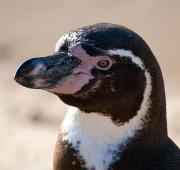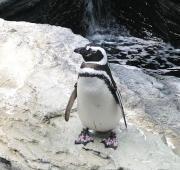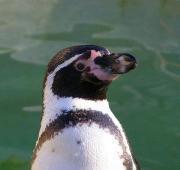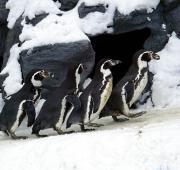 The Humboldt penguin is a medium-sized species of penguin that is found breeding on the coasts of South America. The Humboldt penguin is similar in appearance to and closely related to other more northern penguin species including the African penguin, the magellanic penguin and the Galapagos penguin.
The Humboldt penguin is a medium-sized species of penguin that is found breeding on the coasts of South America. The Humboldt penguin is similar in appearance to and closely related to other more northern penguin species including the African penguin, the magellanic penguin and the Galapagos penguin. The Humboldt penguin is one of the most northern-dwelling penguin species as it is found natively breeding on the coastlines of Peru and Chile. The Humboldt penguin is named after the cold water current that it spends most of it's time swimming in, which is itself named after the explorer, Alexander von Humboldt.
The Humboldt penguin is one of the most northern-dwelling penguin species as it is found natively breeding on the coastlines of Peru and Chile. The Humboldt penguin is named after the cold water current that it spends most of it's time swimming in, which is itself named after the explorer, Alexander von Humboldt.


The Humboldt penguin is a carnivorous animal, that like all other penguin species, survives on a diet that is only comprised of marine animals. Krill and small crustaceans make up the bulk of the Humboldt penguin's diet along with larger organisms including squid and various species of fish. Humboldt penguins can be at sea for days at a time whilst hunting and catch their food by diving deep into the water for minutes at a time.
The Humboldt penguin has few predators on land, the main ones being large snakes and sea-birds that hunt their eggs . Large leopard seals hunt the Humboldt penguin in the water along with large sharks and killer whales. Humboldt penguin populations have also been seriously affected by human hunting, and are easily affected by changes in the water from oil spills and chemical pollutants.
Humboldt penguins nest on beaches and rocky islands along the South American coast, where their range in Chile overlaps that of the closely related magellanic penguin (these sites are known as rookeries). The female Humboldt penguin lays two eggs which are incubated for just over a month and usually fledge (leave the nest) when they are between 2 and 3 months old.
Today, the Humboldt penguin populations throughout the Pacific Ocean have been drastically declining over the past few years, with human interference (mainly habitat loss and over-fishing) being the main cause.

